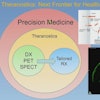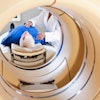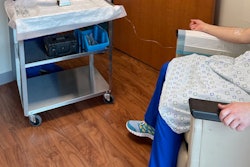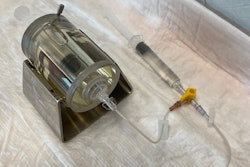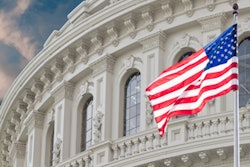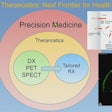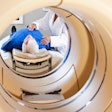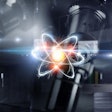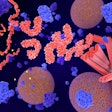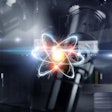Radiology societies are standing firm against a bill in Congress that could disrupt how certain “medical events” are reported in nuclear medicine. Yet the bill's proponents say the issues at hand are transparency and patient safety.
The Nuclear Medicine Clarification Act of 2025 (H.R. 2541) was reintroduced in the House on April 2 by Representative Don Davis (D-NC), Morgan Griffith (R-VA), and Ben Cline (R-VA). The bill would direct the Nuclear Regulatory Commission (NRC) to require providers to report extravasations during PET or SPECT scans -- where injected radio tracer material leaks into surrounding tissue -- as mistakes.
Controversy dates to 2020
The origin of the bill dates back to a May 2020 petition accepted by the NRC by Cary, NC, medical device manufacturer Lucerno Dynamics. The petition asked the NRC to consider diagnostic nuclear medicine extravasations to be reported by providers. While the NRC requires therapeutic extravasations exceeding doses of 0.5 Sv to be reported, diagnostic extravasations have been exempt under that threshold since 1980.
The problem with Lucerno’s proposal, according to the Society of Nuclear Medicine and Molecular Imaging (SNMMI), is that clinicians would need to start daily monitoring for rare events.
During a public comment period on the petition, the SNMMI provided the NRC with findings of a review that found that while extravasation of diagnostic radiopharmaceuticals is not uncommon, of more than 3,000 reported cases, only three cases (< 0.1%) resulted in patient symptoms that required follow-up.
“In summary, there is no clinical data that supports Lucerno Dynamic’s claim that extravasation of diagnostic radiopharmaceuticals is a patient safety issue,” SNMMI wrote.
The American College of Radiology (ACR) also commented. Lucerno sells a device that monitors whether radiopharmaceuticals remains near the administration site rather than circulating in the vascular system, as well as software that quantifies dose levels, ACR noted.
“Notwithstanding the extensive lobbying and public relations campaign behind the petition, the petitioner’s proposed methodology for approximately 20 million [nuclear medicine] procedures annually would appear to benefit only the petitioning device company at the direct and continuing expense of patients, health care providers, and regulators,” ACR wrote, in an August 31, 2022 letter to NRC.
Ultimately, the NRC had already begun to revise language in its regulations regarding reporting diagnostic nuclear medicine extravasations, which have been exempt since 1980, yet the commission decided not to include the 0.5 Sv tissue dose threshold in ongoing considerations.
Birth of a bill
In early 2022, patient advocacy group Patients for Safer Nuclear Medicine was established and began spearheading an initiative that would become the Nuclear Medicine Clarification Act of 2023 (H.R.6815). The same language submitted in Lucerno’s NRC petition was included in the bill.
With its reintroduction this April, the organization reiterated that the point of the legislation is to close the 1980 exemption “loophole,” and it took aim at the NCR’s proposed rule on nuclear medicine extravasations, published last August.
“NRC published a draft proposed rule to require reporting of extravasations that result in injury or have the potential to cause injury. The draft proposed rule is insufficient and uses a subjective standard to determine whether an event is reportable, which is contrary to every other radiation safety rule,” said Mary Ajango, a spokesperson for the organization, in a recent statement.
Even worse, there is no transparency, according to Ajango.
“If radiation is inadvertently spilled onto a patient, that incident must be reported to NRC – yet if it is accidentally injected into a patient’s tissue, no report is required. This policy makes zero sense and opens the door to lasting patient harm,” she said.
Ron Lattanze, chief executive officer of Lucerno, noted that since providers aren’t currently required to report these events, patients are left unaware when they occur, while the tissue damage due to extravasations can take months to manifest.
Lattanze also said it was “a joke that the legislation only benefits Lucerno” and that the proposed bill would benefit patients and even potentially nuclear medicine facilities by driving providers to improve their techniques.
“Our product is not required to fix this issue,” he said.
Also, contrary to the evidence submitted to the NCR by SNMMI, Lattanze offered a study published in Frontiers in Medicine in 2018 that demonstrated the major impact F-18 FDG infiltration can have on PET/CT patient staging and that recommended injection monitoring whenever sensitivity of PET/CT scanning is critical.
“H.R. 2541 will ensure that the NRC treats extravasations no differently than any other accidental exposure,” Lattanze added.
NCR’s ongoing efforts
The Nuclear Medicine Clarification Act of 2025 was referred to the House Committee on Energy and Commerce and awaits further action.
If passed, according to the SNMMI and ACR, the 2025 bill would ultimately override the progress the NRC has achieved so far, namely in crafting language that may leave these reporting decisions up to physicians, based on the seriousness of the event.
“The bill would controversially overturn” the NRC’s ongoing rulemaking, an ACR spokesperson told AuntMinnie.com.
In comments on NRC’s proposed rule published last August, ACR said it was generally supportive of the NRC’s approach.
“While we do not see a safety need for revising NRC’s prior policy, the ACR generally supports the Dec. 2022 Commissioner’s decision on SECT-22-0043 to mandate Medical Event (ME) reporting of rare extravasations ‘that require medical attention for a suspected radiation injury,’” ACR wrote, in an October 23, 2024 letter.
The SNMMI agreed that the issue of reporting diagnostic nuclear medicine extravagations is best left in the hands of the NRC, not Congress.
“SNMMI is confident that the NRC possesses the necessary expertise to effectively address this important issue,” said Cathy S. Cutler, PhD, SNMMI president and chair.
The NRC’s final rule on reporting nuclear medicine injection extravasations as medical event is expected in spring 2026.

